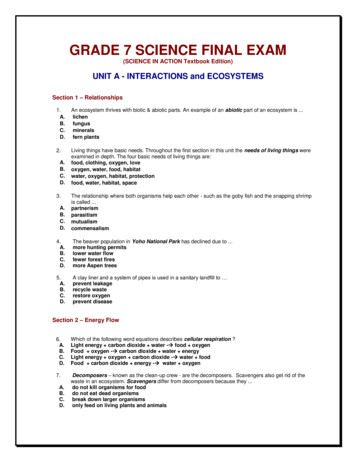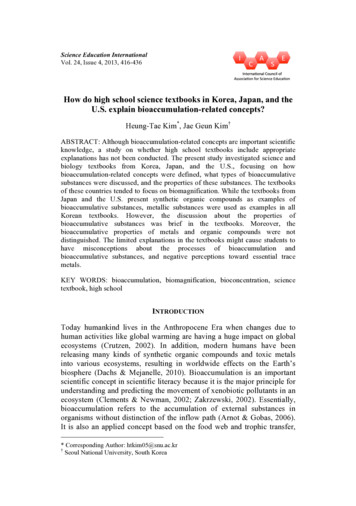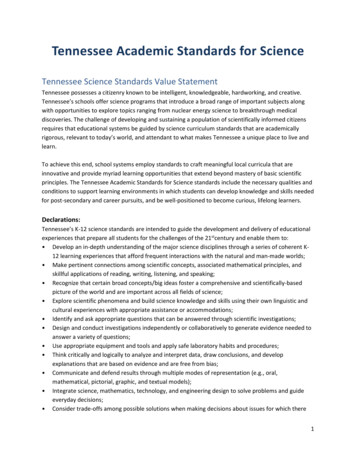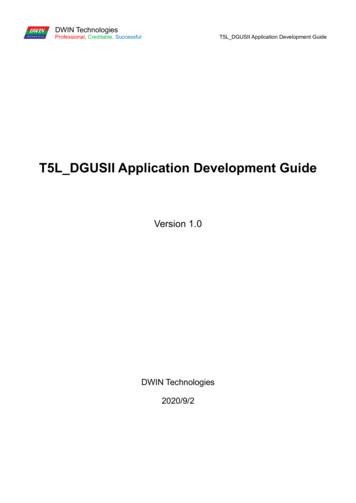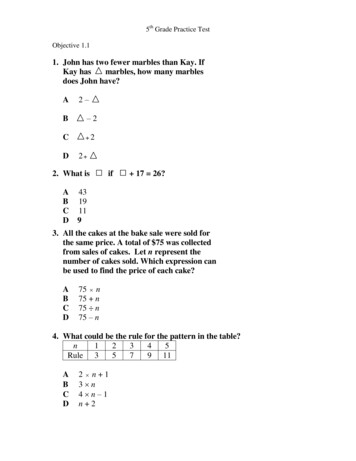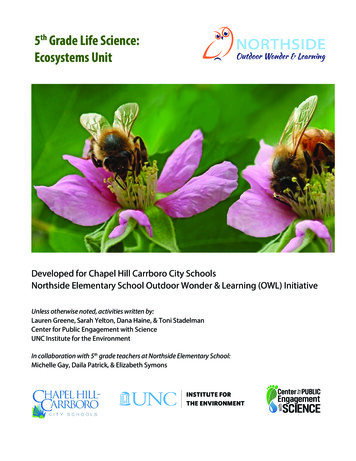
Transcription
5th Grade Life Science:Ecosystems UnitDeveloped for Chapel Hill Carrboro City SchoolsNorthside Elementary School Outdoor Wonder & Learning (OWL) InitiativeUnless otherwise noted, activities written by:Lauren Greene, Sarah Yelton, Dana Haine, & Toni StadelmanCenter for Public Engagement with ScienceUNC Institute for the EnvironmentIn collaboration with 5th grade teachers at Northside Elementary School:Michelle Gay, Daila Patrick, & Elizabeth Symons
ACKNOWLEDGEMENTSMany thanks to Dan Schnitzer, Coretta Sharpless, Kirtisha Jones and the many wonderful teachers andsupport staff at Northside Elementary for their participation in and support of the Northside OWLInitiative. Thanks also to Shelby Brown for her invaluable assistance compiling, editing, and proofreadingthe curriculum.Instructional materials and supplies to promote STEM-based outdoor learning were instrumental to thesuccessful implementation of this curriculum. The purchase of these materials was made possible withfunding provided by the Duke Energy Foundation to Chapel Hill-Carrboro City Schools.Curriculum developed June 2018 – July 2019For more information, contact:Sarah Yelton, Environmental Education & Citizen Science Program ManagerUNC Institute for the Environment Center for Public Engagement with Sciencesarah.yelton@unc.edu
5th Grade Ecosystems UnitNorthside Outdoor Wonder & Learning Initiative
Overarching Unit QuestionHow and why do organisms (including humans) interact with their environment, and what are the effects of theseinteractions?Essential QuestionsArc 1: How can I describe and compare different ecosystems?Arc 2: How is energy transferred through an ecosystem?How can I explain the interconnected relationships between organisms and their environments?Transfer GoalsooUse scientific thinking to understand the relationships and complexities of the world around them.Identify real-world dilemmas and opportunities and apply scientific thinking to develop solutions for them.Enduring Understandings (Science) The world has many different environments, and distinct environments support the life of different types oforganisms.Organisms within ecosystems are interdependent and can survive only in environments in which theirneeds can be met.All organisms cause changes in the environment where they live and they, in turn, are affected by changesin their environment.Target Science Essential Standards5.L.2 Understand the interdependence of plants and animals with their ecosystem.5.L.2.1 Compare the characteristics of several common ecosystems, including estuaries and salt marshes, oceans,lakes and ponds, forests, and grasslands.5.L.2.2 Classify the organisms within an ecosystem according to the function they serve: producers, consumers,or decomposers (biotic factors).5.L.2.3 Infer the effects that may result from the interconnected relationship of plants and animals to theirecosystem.Secondary Target Standards (ELA, Math, Social Studies)ELARI.5.1 Quote accurately from a text when explaining what the text says explicitly and when drawing inferencesfrom the text.RI.5.2 Determine two or more main ideas of a text and explain how they are supported by key details;summarize the text.RI.5.4 Determine the meaning of general academic and domain-specific words and phrases in a text relevant toa grade 5 topic or subject area.SL.5.1 Engage effectively in a range of collaborative discussions (one-on-one, in groups, and teacher-led) withdiverse partners on grade 5 topics and texts, building on others’ ideas and expressing their own clearly.5th Grade Ecosystems Unit1Northside Outdoor Wonder & Learning Initiative
SL.5.4 Report on a topic or text or present an opinion, sequencing ideas logically and using appropriate facts andrelevant, descriptive details to support main ideas or themes; adapt speech to a variety of contexts andtasks.L.5.4 Determine and/or clarify the meaning of unknown and multiple-meaning words and phrases based ongrade 5 reading and content, choosing flexibly from a range of strategies: context clues, word parts, wordrelationships, and reference materials.L.5.6 Acquire and use accurately grade-appropriate general academic and domain-specific words and phrases,including those that signal contrast, addition, and other logical relationships.Math5.MD.2 Represent and interpret data.Social Studies5.G.1.1 Explain the impact of the physical environment on early settlements in the New World.5.G.1.2 Explain the positive and negative effects of human activity on the physical environment of the UnitedStates, past and present.Unit OverviewIn this unit students will learn how all living organisms are interdependent upon each other, as well as the nonliving factors within an ecosystem. The activities in this unit provide students with opportunities to develop skillssuch as observation, critical thinking, communication, collaboration, and creativity. They will investigate theirschool yard and ecosystems surrounding it by using direct observations and completing nature journalingactivities.In Arc 1, students learn about the abiotic and biotic factors in ecosystems. They begin exploring the ecosystemaround their schoolyard and record their observations in a nature journal. Students then take a virtual trip downthe Cape Fear River and discover different types of aquatic and terrestrial ecosystems. They explore ocean habitatsand the creatures that inhabit different ocean zones and play a game to match animals to their ecosystems. TheArc wraps up by having students revisit their schoolyard to compare and contrast how it looks now and how itmay have looked 250 years ago.Arc 2 provides students with opportunities to learn how energy flows through ecosystems by studying foodchains and food webs. The Arc begins with students learning about ecology, which is the study of therelationships between plants, animals, people, and their environment. Other activities allow students to analyzewhat happens when food chains and food webs become unbalanced through changes in the environment. Asstudents work through these activities, they gain an understanding of how organisms are interdependent withinan ecosystem. The unit wraps up with an exploration of how ecosystems provide services that impact humanhealth.Duration 20-24 days of 45 minute learning activitiesVocabulary *Ecosystem, environment, biome, terrestrial, tundra, taiga, deciduous forest, rainforest, grassland, desert, aquatic,wetland, ocean, river, lake, pond, estuary, organism, biotic, abiotic, producer, consumer, decomposer, predator,prey, herbivore, carnivore, omnivore, scavenger, food chain, food web, population, community, competition,photosynthesis, organic, biodiversity, interdependence, conservation, limiting factor* Definitions of vocabulary words can be found on the arc overview pages. Relevant vocabulary is listed on eachlearning activity page.5th Grade Ecosystems Unit2Northside Outdoor Wonder & Learning Initiative
Go Outdoors! Tips & ToolsTaking your class outside for science or any lessons can be rewarding and challenging. Along with behavior andmaterials management tips with each lesson, this section is intended to help you have the tools you need tosuccessfully take your class outside.Before You Go Outside Create ground rules with students for all outdoor lessons. Post the rules for students to be able to easily see.Ask for parent volunteers. Extra help can make an outdoor learning experience much more manageable.Teach students proper use, including safety, of the science tools they will be using.Set expectations before go. Give instructions both inside and repeat once outside.Have a clear objective for going outdoors. This will help focus students’ attention.Be flexible. Structure lessons to take advantage of opportunities and challenges.Establish a meeting spot and emergency plan. Have a signal for emergency situations.Take students outside for short exercises to practice rules before longer outdoor lessons.Use same door to always go outside for learning. Emphasize this is different than going outside for recess.While You Are Outside Model the activities and outdoor skills for students. Show them what you expect them to be doing.Participate in the activity. Get down on your students’ level. Get your hands dirty.Model respect for nature with your students.The outdoors is full of teachable moments. Use “I wonder” statements to engage students in questioning theexperience. Have students write down questions to be researched back in the classroom.Allow students to be leaders in the activity. Ask students to volunteer as teacher assistant or materials manager.Acknowledge that students want to explore and can do so once the assigned task is complete.Safety First! Scout outdoor areas ahead of time if possible, to note potential hazards such as poison ivy.Students should never be alone. If a student needs to go back to the building, send 2 students.Take a first aid kit and phone/walkie-talkie. Consider bringing along staff trained in first aid/CPR.Let office staff know where you and your class are going if headed out on a walking field trip.Stay on the trail/path, unless otherwise directed. On the greenway, stay on the right side of path.Do not eat wild plants, unless harvesting in the garden with a teacher.Set boundaries for the students to stay within. You have to be able to see me and I have to be able to see you!A Note on Nature JournalingNature journals that you use with your class should be small composition books or other blank books that studentsuse to make outdoor observations, including writing, drawing, and painting. Students can use colored pencils,watercolor pencils, or other materials to remember details of plants, animals, and habitats they are investigatingaround the schoolyard. This is different from a science notebook. However, some teachers may choose to havestudents paste blank pages into their science notebook to use for nature journaling pages.5th Grade Ecosystems Unit3Northside Outdoor Wonder & Learning Initiative
Arc 1 – EcosystemsEssential QuestionsHow can I describe and compare different ecosystems?NC Science Essential Standards – Unpacked Content5. L.2.1 Students know that there are different types of ecosystems (terrestrial and aquatic). These ecosystems canbe divided into two types according to their characteristics:TerrestrialLand-based ecosystems include forests and grasslands.Forests have many trees (with needles or with leaves), shrubs, grasses and ferns, and a variety of animals.They usually get more rain than grasslands. Diverse types of animals can be found in forests, dependingon their type. Deciduous: black bear, deer, red fox, vole, rabbit, cardinal. Rainforest: panther, monkeys,capybara, snakes, spiders. Temperatures in the forests may vary depending on where the forest is located.Grasslands have fertile soil and are covered with tall grasses. They usually get a medium amount of rain,but less than forests. Temperatures may also vary depending on where the grassland is located. Someexamples of animals that live in the grasslands are prairie dogs, bison, and grasshoppers.AquaticWater-based ecosystems may be fresh water (lakes and ponds) or saltwater (oceans, estuaries andsaltwater marshes).Lakes and ponds are bodies of freshwater that are surrounded by land. Ponds are usually shallower thanlakes and the temperature of the water usually stays the same from top to bottom. Plants and algaeusually grow along the edges where the water is shallow. Some examples of animals may be differenttypes of fish, amphibians, ducks, turtles, or beavers.Oceans are large bodies of saltwater divided by continents. Oceans have many types of ecosystemsdepending on the conditions (sunlight, temperature, depth, salinity) of that part of the ocean.Most organisms live where the ocean is shallow (from the shoreline to the continental shelf) becausesunlight can reach deep and the water is warm making food abundant. Some examples of organisms thatlive in the shallow ocean are drifters (jellyfish or seaweed), swimmers (fish), crawlers (crabs), and thoseanchored to the ocean floor (corals).Some organisms live in the open ocean, near the surface or down to the deep ocean bottom. Planktonfloat in the upper regions of the water.Some organisms swim to the surface to find food or for air (whales, turtles, sharks) while others live closerto the bottom (certain fish, octopus, tubeworms).Students know typical visual representations of the various ecosystems, as well as graphic representationsof the food chains and webs, cycles and energy pyramids that are commonly associated with ecosystems.5th Grade Ecosystems Unit4Northside Outdoor Wonder & Learning Initiative
Lessons in this Arc Engaging Activity: What’s in your Ecosystem?Learning Activity 1: Reading About EcosystemsLearning Activity 2: Ecosystems Around the SchoolLearning Activity 3: Exploring the Cape Fear River BasinLearning Activity 4: Ocean HabitatsLearning Activity 5: Move Over RoverLearning Activity 6: Your School Ecosystem: Then & NowGo Outdoors!Nature Journal Connection Engaging Activity: What’s in your Ecosystem? Learning Activity 2: Ecosystems Around the School Learning Activity 6: Your School Ecosystem: Then& Now Engaging Activity: What’s in your Ecosystem?Learning Activity 6: Your School Ecosystem:Then & NowDuration: 9 to11 days of 45 minute learning activitiesBackground InformationAn ecosystem includes the living things interacting in an area along with the non-living environment. Abioticfactors are the non-living components of an ecosystem, such as precipitation, oxygen and sunlight. Biotic factorsdescribe all the living components of an ecosystem, including various organisms. An organism is a living thing,such as animal, plant, or micro-organism, capable of reproduction, growth and maintenance. The environment iscomprised of the abiotic and biotic influences that act upon an organism, population, or ecological community.A biome is a distinct biological community consisting of plants and animals in a shared environment. A biome justconsiders the living components in an area, while an ecosystem considers both living and non-living componentsin an area. More than one ecosystem can make up a biome.Ecosystems are classified based on their different characteristics. Terrestrial ecosystems are found on land.Among terrestrial ecosystems, the tundra is an arctic ecosystem with permanent layers of frozen soil and lackstrees. The taiga is a forest ecosystem with conifer trees which produce cones. It begins where the tundra ends. Adeciduous forest is characterized by trees that lose their leaves each fall. The rainforest ecosystem has highlevels of rain and many trees. The grassland ecosystem is covered with tall grass and has fertile soil. The desertreceives very little rainfall and as a result, has very few plants. Plants that exist in the desert, such as cacti, areadapted to living in dry environments.Aquatic ecosystems are located in water or wet environments. A wetland has saturated soil due to standingwater most of the year and includes many plants. The ocean is a large body of salty water. A river is a flowingbody of water surrounded by land on two sides. A lake is a body of freshwater surrounded by land. Thetemperature difference is significant from the surface to the bottom of the lake. A pond is a body of fresh waterwith a consistent temperature from the surface to the bottom. It is also surrounded by land. An estuary is theconvergence point of freshwater and saltwater, resulting in brackish water.5th Grade Ecosystems Unit5Northside Outdoor Wonder & Learning Initiative
Vocabulary Abiotic factors are the non-living characteristics of an ecosystem (e.g. temperature, precipitation).Aquatic means growing or living in or often found in water.Biome is a large region of Earth that has a certain climate and certain types of living things.Biotic factors are living things.Deciduous Forest is a type of ecosystem with many trees that lose their leaves in the fall.Desert is a type of ecosystem with very little rainfall and few plants.Ecosystem includes all of the living things (plants, animals and organisms) in a given area, interacting witheach other, and also with their non-living environments (weather, earth, sun, soil, climate, atmosphere).Environment is all of the biotic and abiotic factors that act on an organism, population, or ecologicalcommunity and influence its survival and development.Estuary is a type of aquatic ecosystem where freshwater and saltwater mix creating brackish water.Grassland is a type of ecosystem with fertile soil and are covered with tall grasses.Lake is a type of aquatic ecosystem that is a body of freshwater surrounded by land and deep enough thatthe temperature changes from the top to the bottom.Ocean is a type of aquatic ecosystem that is a large body of salt water.Organism is a living thing, such as animal, plant, or micro-organism, that is capable of reproduction, growthand maintenance.Pond is a type of aquatic ecosystem that is a body of freshwater surrounded by land and is shallow enoughthat the temperature is the same from the top to the bottom.Rainforest is a type of ecosystem with many trees and abundant rainfall.River is a type of aquatic ecosystem in which the water is flowing in one direction and has land on two sides.Taiga is a type of forest ecosystem that consists mostly of cone-producing trees (as pines, spruces, and firs)and begins where the tundra ends.Terrestrial means living on or growing from land.Tundra is a type of ecosystem in the arctic having a permanently frozen layer of soil and no trees.Wetland is a type of ecosystem with abundant plant life where there is standing water and the soil stayssaturated most of the year.Literature ConnectionsBook sets Forests: Inside Out by James Bow, Mountains: Inside Out by James Bow, Wetlands: Inside Out by James Bow,Rivers and Lakes: Inside Out by Megan Kopp, Islands: Inside Out by Megan Kopp* Explore the Deciduous Forest by Linda Tagliaferro, Explore the Tundra by Linda Tagliaferro, Explore the TropicalRain Forest by Linda Tagliaferro, Explore the Grasslands by Kay Jackson, Explore the Deserts by Kay Jackson,Explore the Ocean by Kay Jackson* Habitat Survival: Grasslands by Buffy Silverman, Habitat Survival: Polar Regions by Melanie Waldron, HabitatSurvival: Wetlands by Buffy Silverman, Habitat Survival: Mountains by Melanie Waldron, Habitat Survival:Forests by Claire Llewellyn, Habitat Survival: Rivers by Melanie Waldron, Habitat Survival: Deserts by MelanieWaldron, Habitat Survival: Oceans by Claire Llewellyn**currently available in Northside Elementary’s media center5th Grade Ecosystems Unit6Northside Outdoor Wonder & Learning Initiative
Engaging ActivityWhat’s in your Ecosystem?Lesson Prep Find an area where students can work in their nature journalswithout being disturbed. Make sure students have nature journaling materials or have pastedblank paper into a page of their science notebooks ahead of time.VocabularyLearning Objectives:Students will be able to identifyabiotic and biotic features of aschoolyard ecosystem.Abiotic factors, biotic factorsNutshell/Skills:Students can make observationsabout parts of an ecosystem.ProcedureScience Essential Standards:5.L.2.2Independent Work: Take students outdoors and invite each student to find a spot wherehe/she can sit and complete their nature journaling activity. Nature Journaling prompt:o Using your senses of sight, hearing, smell, and touch, make a listof everything you notice around you.o Give students a time limit.o Instruct students to leave enough room next to each item tolabel it with a letter.Mini Lesson: After writing in their Nature Journals, explain the terms biotic andabiotic to the class. Biotic refers to anything in an ecosystem that is or once was living,such as plants, animals, fungi, fallen logs, and leaves on the ground. Abiotic refers to anything in an ecosystem that is not nor ever hasbeen living, such as rocks, soil, sun, clouds, precipitation, andanything else weather-related. Ask students to write these definitions in their journals. Ask students to label each item they listed in their journals with an“a” or a “b” to indicate whether the item they observed is abiotic orbiotic. On chart paper, make a T-Chart. Label one side “Abiotic” & the otherside “Biotic”. Have students take turns writing their items in thecorrect column. Ask students if they saw any of the abiotic and/or biotic factorsinteracting such as a bird drinking water, etc. Explain that all living things (biotic) and all non-living things (abiotic)interacting together make up an ecosystem. What the studentsobserved on the school grounds is an example of a small ecosystem. Ask students if they can think of larger ecosystems.5th Grade Ecosystems Unit7ELA Essential Standards:L.5.6Time:45 minutesTeacher Materials:o Chart paperStudent Materials:o Nature Journalso Pencilso Private EyesNorthside Outdoor Wonder & Learning Initiative
Assessment: Exit ticket: Describe the difference between “biotic” and “abiotic” and provide an example of each.Opportunities for Extended Learning1. Provide students with additional nature journaling opportunities where they can practice makingobservations by drawing and labeling what they see around them. This will help improve their observationalskills.Behavior Management Tips Prior to going outdoors, discuss with students the importance of respecting nature both biotic and abioticthings. Examples include things such as:o leave worms and other animals aloneo leave rocks, soil, and grass where you found them Define the boundary for where the students can sit and work on their nature journaling prompt.5th Grade Ecosystems Unit8Northside Outdoor Wonder & Learning Initiative
Learning Activity 1Reading About EcosystemsLesson Prep Make copies of the graphic organizers, 1 of each per student. Preview and be prepared to show the BrainPOP videos. Gather book sets. Ideally, get books that cover 5 differentecosystems, including forests, grasslands, oceans, and fresh water.VocabularyEcosystem, environment, biome, terrestrial, tundra, taiga, deciduous forest,rainforest, grassland, desert, aquatic, wetland, ocean, river, lake, pond,estuary, organism, biotic, abioticNote: The vocabulary in this lesson can be impacted by which books youchoose for the class to use.Nutshell/Skills:Students can describe thecharacteristics of different types ofecosystems.Science Essential Standards:5.L.2.1ELA Essential Standards:RI.5.2, RI.5.4, RF.5.4, SL.5.1, SL.5.4Social Studies Essential Standards:5.G.1.2Procedure Part 1Mini-Lesson Show the BrainPOP video on Ecosystems (1:40) to reinforce theEngaging Activity lesson on ecosystems and the various types ofecosystems. Then show Land Biomes (2:32).Time:1-2 sessions of 45 minutes eachIndependent Group Work Choose a group of book sets that covers multiple ecosystems, such asthe Ecosystems Inside Out series, Explore the Biomes series, or theHabitat Survival series. Have a student pass out a copy of the Reading About Ecosystemsgraphic organizer to each student. Divide the class into groups and allow each group to choose whichecosystem they will read about.o Each student in a group will receive a book about their selectedecosystem. Tell the students they are going to become “experts” on theirselected ecosystem and will be responsible for teaching otherstudents about that ecosystem. Ask students to begin reading to themselves or have them take turnsreading aloud to their group.o Groups should spend time responding to the prompts on theReading About Ecosystems graphic organizer including thevocabulary section on the back of the sheet.5th Grade Ecosystems UnitLearning Objectives:Students will describe thecharacteristics of differentecosystems.9Teacher Materials:o BrainPOP on Ecosystemso BrainPOP on Land Biomeso BrainPOP LoginStudent Materials:o Book sets about ecosystems withpreference to Ecosystems InsideOut serieso Copies of Reading AboutEcosystems and Reading AboutEcosystems - Jigsaw graphicorganizers, one set per studentNorthside Outdoor Wonder & Learning Initiative
Procedure Part 2Independent Group Work Regroup the students so that each new group will have at least one member representing each of thefeatured ecosystems. The students will take turns teaching what they have learned about their chosen ecosystem to their newgroup. Students will complete the Reading About Ecosystems – Jigsaw graphic organizer while learning about theother ecosystems. By the end of the activity, the students will have recorded information on at least five different ecosystems.Assessment Use the rubrics provided to assess the Reading About Ecosystems graphic organizer and the Reading AboutEcosystems – Jigsaw graphic organizer.Opportunities for Extended Learning1. Show additional BrainPOP videos that focus on specific habitats: Oceans “Underwater World”, Wetlands“Everglades”, “Tropical Rainforests”, “Taiga”, “Tundra”, “Savanna”, “Deserts”2. Have students use the ecosystems vocabulary foldable throughout the unit to take notes or at the end ofthe unit as review. It can also be used as an assessment. Students should fold it into thirds to make abrochure of ecosystems information.5th Grade Ecosystems Unit10Northside Outdoor Wonder & Learning Initiative
NameReading About EcosystemsRead the book about your assigned ecosystem and complete this worksheet. You will then share what youlearned with your classmates.1. Identify your ecosystem.2. Make a diagram to show an example of a food web or food chain in your ecosystem. Label your diagram. Drawarrows to show the flow of energy. Remember, food webs and food chains show energy flow in an ecosystemthrough what eats what, including plants and animals.3. Describe 3 things about your ecosystem, such as the types of plants, animals, and weather conditions.4. List 2 examples of your ecosystem and tell where they are located.5. What is one threat to your ecosystem?6. What is one way you can protect your ecosystem?5th Grade Ecosystems Unit11Northside Outdoor Wonder & Learning Initiative
5th Grade Ecosystems Unit12Northside Outdoor Wonder & Learning Initiatived)c)b)a)Vocabulary WordThe sentence in the bookWhat I think the word meansThe context clues I usedThe definition from the glossary7. Determine the meaning of 4 vocabulary words by completing the chart below. Use context clues to write a definitionbefore using the glossary to write the book’s definition of the words.
NameReading About Ecosystems - JigsawRecord information about each ecosystem shared with :Examples:Human impact:Human les:Examples:Human impact:Human impact:5th Grade Ecosystems Unit13Northside Outdoor Wonder & Learning Initiative
NameScoreRubric for Reading About provementIdentifyyourecosystemEcosystem is correctlyidentified.Ecosystem isidentified by specificexample rather thangeneral type.Ecosystem isincorrectly identified.Ecosystem is notidentified.Food webor chainDiagram of food chainor web including atleast 4 organisms withall organisms labeled.Arrows show the flowof energy fromproducers toconsumers todecomposers.Diagram of foodchain or webincluding at least 3organisms with mostorganisms labeled.Arrows show the flowof energy fromproducers toconsumers todecomposers.Food chain or webmissing some of thelabels or otherwiseincomplete.Food chain or webmissing all labelsOR arrowsincorrectly showthe flow of energy(decomposers toconsumers toproducers).Describe 3thingsspecific toecosystems3 aspects of theecosystem aredescribed.2 aspects of theecosystem aredescribed.1 aspect of theecosystem isdescribed.0 aspects of theecosystem aredescribed.Name 2examplesofecosystemwithlocationAt least 2 specificexamples of the typeof ecosystem withlocation i.e. AmazonRainforest in Brazil.2 specific examples ofthe type of ecosystembut missing 1location.2 specific examples ofthe type of ecosystembut missing bothlocations.1 specific exampleis listed.Threat toecosystemIdentifies a threatspecific to theecosystem.Identifies a threat tothe ecosystem.Identifies a genericthreat to ecosystems.Answer is notsomething that is athreat toecosystems.Ways toprotect theecosystemIdentifies a way toprotect the ecosystemand how they canhelp.Identifies a way toprotect theecosystem.Identifies a genericway to protectecosystems.Answer is notsomething thatprotectsecosystems.Define 4VocabularyTerms4 columns and rowsare complete withaccurate definitionsfor each.3 columns and/orrows are completewith accuratedefinitions for each.2 columns and/orrows are completewith accuratedefinitions for each.1 column and/orrow is completewith accuratedefinitions for each.Comments5th Grade Ecosystems Unit14Northside Outdoor Wonder & Learning Initiative
NameScoreRubric for Reading About Ecosystems - ementEcosystem4 differentecosystems named3 differentecosystems named2 differentecosystems named1 ecosystem namedDescribe4 detaileddescriptions of theecosystems3 detaileddescriptions of theecosystems2 detaileddescriptions of theecosystems1 detaileddescription of theecosystemsExamples4 examples of typesof ecosystems3 examples of typesof ecosystems2 examples of typesof ecosystems1 example of anecosystemHumanImpact4 examples of humanimpact, one perecosystem3 examples ofhuman impact, oneper ecosystem2 examples of humanimpact, one perecosystem1 example of humanimpactComments5th Grade Ecosystems Unit15Northside Outdoor Wonder & Learning Initiative
If the number of squirrels decreases, what likely willhappen to 2 other organisms in the above food web?5th Grade Ecosystems Unit16Northside Outdoor Wonder & Learning Initiative
or5th Grade Ecosystems Unit17Northside Outdoor W
Sep 05, 2019 · a grade 5 topic or subject area. SL.5.1. Engage effectively in a range of collaborative discussions (oneon- -one, in groups, and teacher-led) with diverse partners on grade 5 topics and texts, building on others’ ideas and expressing their own clearly. th Grade E




